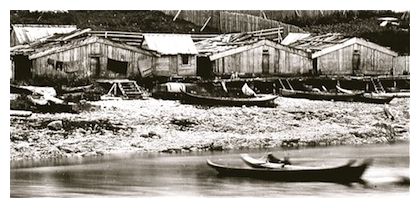
© Photo by Edward Dossetter, 1881Detail of the Heiltsuk village of 'Qlc (Bella Bella).
Vancouver - Oral traditions of the Heiltsuk people tell of the ancient village of Luxvbalis, abandoned after a small pox epidemic in the late 1800s and lost because so few were left to tell the tale.
The village may just have been discovered on a site on Calvert Island, in Hakai Luxvbalis Conservancy, located off British Columbia's central coast and its history could date back to as much as 10,000 years.
"People lost information about the exact location after they were decimated during the epidemics in the 1800s. Based on that oral tradition and how old it was, we think this might be that village," anthropologist Farid Rahemtulla said Monday.
"But we still need to work with the elders of the Heilstuk nation to conclusively establish this," he cautioned.
The discovery started with a routine dig on Calvert Island as part of University of Northern B.C. anthropology program's intensive archeology field school, held every summer.
"Most excavations we have done as part of the field school have been in the (B.C.) Interior. This time, I wanted to explore the coast, which has some of the oldest archeological sites in the province," said Rahemtulla, the director of the project.
He chose one of several shell middens found along the central coast and previously identified by Simon Fraser University researchers, but not yet explored.
"Shell middens are the result of people discarding food remains, building structures, tools, decorative items and hunting equipment," explained Rahemtulla. They usually indicate ancient settlements, whether permanent or transitory."
The most significant aspect of this site, says Rahemtulla was its size.
"This midden was very prominent on the landscape. And as we kept working on it we realized how big it was - both in terms of spatial extent and depth," he said.
It was more extensive than the team had imagined, extending over 150 metres along the bank. "No matter where we put down the pits, we found we were on the midden," said Rahemtulla. This large extent indicates that it was big village populated by a large number of people, he explained.
The depth, on the other hand, - estimated at around four metres so far - taken together with other evidence could be an indication of the site's ancientness.
Exactly how ancient is not clear right now.
"It is all very preliminary. We have to wait for results of radio-carbon dating to get the exact period," he said.
"We didn't get very far down this time, only about a metre and a half," said Rahemtulla, "but in the intertidal zone, on the beach close to the midden, we found a lot of stone tools that have previously been dated to be between 6,000 to 10,000 years old."
"This is very good circumstantial evidence. Potentially this could be a very old village."
So far, the oldest discovered village in British Columbia is at a site called Namu, also located on British Columbia's central coast. It is estimated to be around 10,000 to 11,000 years old.
Elroy White, an archeologist and member of the Heiltsuk First Nations, says the findings and the location are consistent with oral recollections.
Luxvbalis was supposed to be a winter village where everyone gathered to repair their tools, bringing in their summer stores and sharing stories through song and dance. So by definition, it was supposed to be a large place, he said.
In addition, the location is well protected with a sheltered anchorage and access to fresh water. White also refers to physical indications such as a large boulder nearby which features in oral history traditions.
Another significant feature of the site is that the team from UNBC found a large number of fishing tools made from deer bone and antler - harpoons, bone points, fishing hooks and weights.
Rahemtulla says this is an important find as it shows a link between use of land animals as a resource by coastal communities. Animal bone tools have been discovered before, but the link has not been explored previously, he said.
"Prior to the discovery of metals, land animals such as the deer would have been a very important resource for coastal communities - it shows the link . . . how land resources were used to get marine resources."
Reader Comments
to our Newsletter